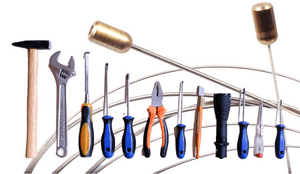
Are you unhappy with your guitar? Before you trade it in for another axe, have you taken a good look at the strings? This article will reveal how to find and fix guitar string problems that can cause your instrument to sound or play badly.
Keep on reading to see if your strings are the things that are making you sad.
You can use the table of contents below to take you to the area that interests you. Click on the little box to open it and then click on the section of the article you want to read, or you can read from start to finish if you want the full guitar string experience!
Strings Affect Your Guitar’s Sound And Playability!
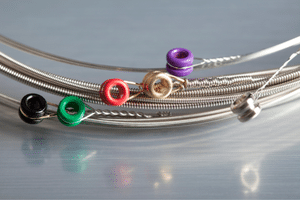
Before we start, let me say that if you’re thinking that your guitar strings have something to do with the problem you are having with your guitar, then they probably do!
Many guitar players do not realize how many ways and to what extent the type and brand of strings can affect their guitar. Even more subtle are how a guitar can affect the performance of a set of strings.
I have seen beginning guitar students go through several instruments simply because they did not understand the importance of how a guitar string creates and transfers vibrational energy when it is plucked and fretted.
Here are some of the most common problems involving guitar strings and what you can do about them to get your guitar playing and sounding great.

Where Did My Tone Go (And Why Strings Can Affect It)?
If your guitar sounded great when you got it, but now it just doesn’t sound right, then either something happened, and you didn’t notice, or you made some adjustment or modification that caused the problem.
Always Play With Fresh Strings
Before you bury the guitar in your backyard, the first thing you should do is give it a new set of strings, especially if they haven’t been changed in a while!
Dirty or worn-out strings are the most common tone-killer of guitars. Always wipe down your strings after you play with a clean cloth. Wipe the tops, sides, and underneath. You might be surprised at how much dirt is on the fabric!
There are also a variety of string-cleaner products that you can use, which won’t harm your fretboard. More on that to come, so keep on reading!
Keep Your String Gauge Consistent
Did you change your string gauge (thickness) without doing a setup on your guitar? Most guitars come from the factory adjusted to play and sound best with a particular type and gauge string.
If you change your string gauge and notice your tone go down the drain, the guitar needs to be readjusted to compensate for the difference in string tension, especially if you went down or up more than one gauge size.
An electric guitar that was strung with .010 gauge strings will give you a problem sooner or later if you restring it with .008 gauge without making some adjustments.
It most likely needs at least a neck truss rod adjustment, which you should never do on your own if you don’t know the proper method, or you could permanently damage your guitar!
Get A Professional Setup
If you still can’t revive your guitar tone, it’s time for a professional setup, which can be done at some music stores or by a luthier (guitar designer and builder). You should not attempt to do this on your own unless you have the proper tools and experience.
If you want to take a troubleshooting approach to fix your string problems, look at the categories below to find the answer.
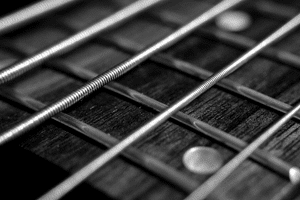
Strings Are Hard To Press Down
When the strings on your guitar are hard to press down, it can be painful to play after a while, especially if you are a beginner and don’t have calluses on your fingertips.
For more info, see Fingertips Hurt Playing Guitar? – How To Stop The Pain!
Even advanced players can have problems playing complicated or high-speed passages when their guitar is not set up correctly.
String Height (Action) Is Set Too High
If your strings are too high above the frets, they will require more force to press down and more pressure against the frets to make them sound clear with a good tone. They should be low enough to make the guitar easy to play but not too low as to create other problems like string buzz and intonation issues.
Strings Are Too Thick
If you like rich tone, then you probably favor thicker gauge strings. Thick gauge strings are ideal for playing rhythm guitar, but if you are doing a lot of soloing, consider dropping your string thickness a gauge or two.
I like to string my electrics with .010 or .009 gauge sets, depending on the guitar. They give you a good tone and are easier to bend. I tried .008 gauge sets but found them to be a little thin-sounding.
It’s all a matter of personal taste. Billy Gibbons gets a phenomenal tone out of his custom Dunlop set of .007 gauge, which is commercially available, so use whatever works best for you and on your particular guitar.
For more info, see Guitar String Gauge Guide – Finding Your New Sound!
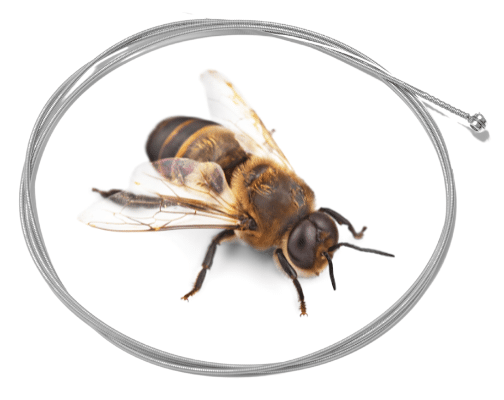
Strings Make A Buzzing Sound
String buzz is something that plaques every guitar player to some degree, especially if you really dig in with your pick.
String Height (Action) Is Set Too Low
One of the most common causes of string buzz is setting your action too low, especially on the Low E, A, and D strings. Thinner gauge strings are more likely to buzz if set too low because they are under less tension and can move more in every direction when they vibrate.
Picking the strings with a lighter touch or using a thinner guitar pick will usually help reduce string buzz.
Smaller String Gauges May Require A Truss Rod Adjustment
Switching to a lower string gauge can cause string buzz that requires a truss rod adjustment, especially with a big gauge drop, like going from a .010 gauge set to a .008 gauge set.
This happens because the lighter gauge lowers the string tension that pulls on the neck and creates a “back bow” (an upward or convex curve) in the fretboard’s profile.
The truss rod needs to be loosened to straighten the neck to correct this. Please do not attempt to adjust the truss rod unless you know how to do it properly or you could permanently damage the neck.
The opposite is also true. Going from a smaller gauge string set to a larger gauge can require a truss rod tightening to straighten a “bow” (downward or concave curve) in the neck.
Guitar Strings Can Wear Down Areas On The Frets
Steel strings will eventually wear down the frets of your guitar. Stainless steel strings will wear down nickel frets quicker than nickel alloy strings. Stainless steel frets will last a lot longer and feel smoother when bending strings.
If you are a frequent string bender and use a lot of finger vibrato, you will wear down frets unevenly. These worn-down areas under the High E, B, and G strings can cause string buzz.
Jumbo frets can last longer than vintage low-profile frets without noticeable buzzing because the strings are farther away from the wood of the fretboard.
Badly worn frets may need to be dressed and re-crowed or replaced. Do not attempt to work on your frets unless you have the proper tools and experience. Take your guitar to a certified guitar tech or luthier (guitar designer and builder).

Strings Are Difficult To Bend
Strings Are Dirty Or Worn Out
Dirty and worn-out strings can be more difficult to bend because they require more tension to tune correctly.
If you notice your strings getting harder to bend or do finger vibrato, the best thing to do is to slap on a new set. They are probably beyond cleaning them to correct the problem.
Strings Are Too Thick
Most string bending players use a medium or light-gauge string set. I like .009 or .010 gauge sets on my electric guitars. I have a few semi-hollowbody electrics with .011 gauge sets, which help bring out more tone richness. So it’s definitely a game of “give and take.”
One of the best ways to condition your fingers to bend thicker strings on your electric is to play your acoustic guitar consistently for a few weeks. When you go back to the electric, you’ll find things have gotten a lot easier!
The opposite can also be true. If the strings are too thin on a guitar with very low action and a small fretboard radius (like 7.25 inches), you might find bending the strings harder. This is because your fingers can slip off the top of the strings, especially if you play fast. However, if your hands are big enough, you can bend anything easily.
String Height Is Not Set Correctly
Each guitar has an ideal string height (action) to make string bending the easiest. This depends on the individual player, the fretboard radius, and the string gauge. “Shred guitars” typically have a flat (12 to 15 inch) fretboard radius set up with low action and thin (.008 to .009) gauge strings.
If your guitar has a double-locking tremolo and you do a lot of aggressive whammy bar licks, like divebombs, then you will have to set your action higher to keep the strings from bottoming out, even with a flat fretboard.
For more info, see Learn To Play A Guitar Fast – Best Tips And Tricks!
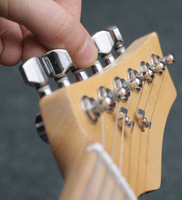
Tuning Problems
Strings Are Dirty Or Worn Out
A dirty or worn-out string can be hard to tune precisely and keep in tune while playing the guitar.
It’s good practice to clean your strings after playing your guitar. If your hands sweat a lot, then wipe or wash them between sessions.
Strings Are Not Wound On Tuning Machines Properly
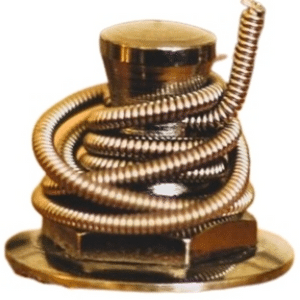
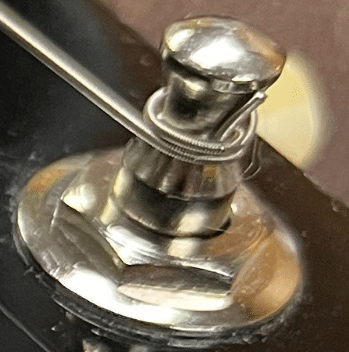
The way you wind each string onto its tuning machine is critical to the string’s tuning stability!
This is a problem I see quite often, and I was guilty of doing this when I first started playing. I thought the more overlapping windings I put on a string’s tuning machine the, better it would stay in tune.
Overlapping windings destabilize your guitar’s tuning! It’s better to have 2 to 4 adjacent non-overlapping winds and “lock” the string under the top winding.
Strings Are Getting Stuck In The Nut Slots
If you use a tremolo bar, strings can go out of tune if they get stuck in the slots of the guitar nut. This is because as you raise and lower the whammy bar, the strings slide a little through the nut slots in both directions to stabilize the tension on each side of the nut.
If the strings get bound up when moving in either direction, they can go sharp or flat. To correct this problem, check to ensure that the nut slots are smooth and the proper size for the strings. If you change to a much larger gauge string set, the nut slots may need to be widened.
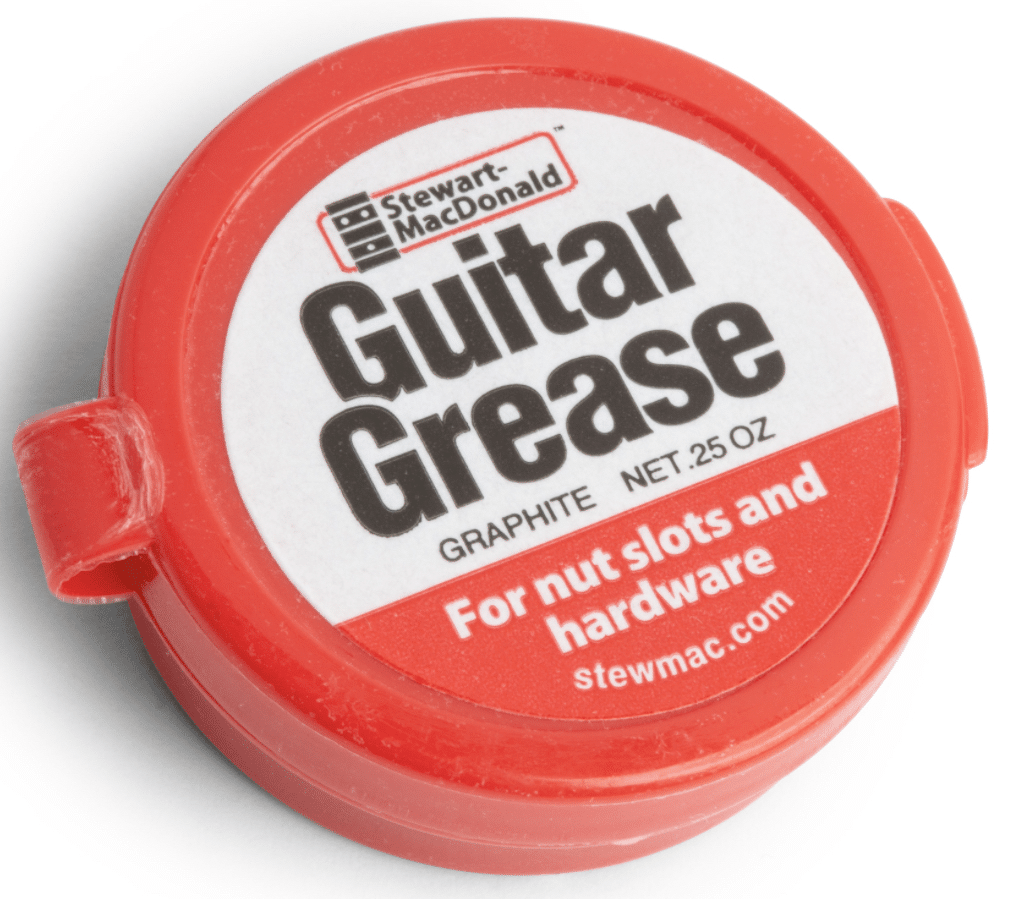
Do not attempt to file the nut slots if you don’t have the proper tools or experience, or you could wreck the nut.
If the nut slots are not too narrow, you can lubricate them with the graphite from a pencil or nut a lubricant, like Stew-Mac “Guitar Grease.”
Replacing a plastic or bone nut with a self-lubricating graphite nut or a Fender LSR roller nut can help solve the problem.


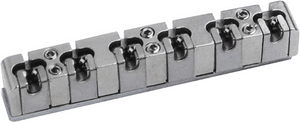
Strings Are Going Out Of Tune From Using A Whammy Bar
If you have a guitar with a whammy bar, the best way to keep strings in tune is to use locking tuners or a locking nut.
The locking tuners work well for an electric guitar with a non-locking tremolo. Locking tuners can work even better to help fix tuning problems if you use them together with a graphite or roller nut!
If you have a locking tremolo, then a locking nut is best for keeping the strings from going out of tune. This is the so-called “double-locking” tremolo system, and it is the best way to keep your strings in tune if you use a whammy bar.
You don’t need both locking tuners and a locking nut. That’s just overkill because the locking nut renders the function of the locking tuners useless.
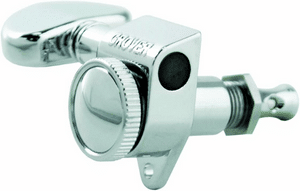
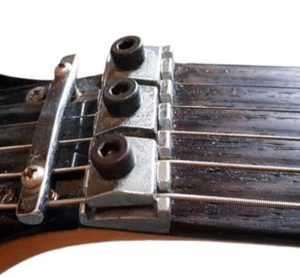
For more info, see How To Keep An Electric Guitar In Tune.
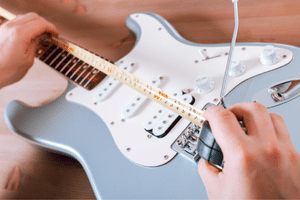
Intonation Issues
Strings Are Dirty Or Worn Out
As guitar strings get dirty and begin to wear out, their shape gets distorted, and their surface can become pitted.
As you play through a set of strings, you will begin to notice problems with the guitar’s intonation, meaning that notes on the fretboard will not be in tune everywhere up and down the neck. The first thing you should do is put on a new set of strings.
If this does not correct the problem, you can look for other causes.
Strings Are Too Close To The Guitar Pickups
Many electric guitar players like to put the strings as close as possible to the pickups to get the most robust signal output. This usually compromises the pickups’ tone and can cause a variety of other problems.
Placing the guitar’s strings too close to the pickups can cause intonation problems because pickups exert a magnetic pull on the strings that is too strong and prevent them from vibrating correctly.
This can cause some strange sounding overtones called “wolf tones” because the pickup’s magnetic field aligns the resonant frequency of the string vibration to that of the vibrating guitar body.
Too strong a magnetic pickup pull can also dampen the notes’ harmonics.
Pickups that are too close to the strings can also make bending strings and finger vibrato more difficult.
When setting the height of a guitar’s pickup, the best approach is to find its “sweet spot” by playing the guitar all over the neck each time you make a slight adjustment. This will allow you to get the best sound and avoid magnetic pull problems.
String Distance From The Guitar’s Bridge Saddles To Nut Is Too Short Or Long
If the string distance from the guitar’s bridge saddles to the nut is not set correctly for the neck scale and the string gauge, the intonation will be off. Electric guitars typically have saddles that can be adjusted toward or away from the nut to shorten or lengthen the distance.
Stratocasters and Les Pauls have six adjustable bridge saddles (one for each string), while some Telecasters may have three adjustable bridge saddles (one for every two adjacent strings).
If you change the gauge size or the string material (e.g., steel versus cobalt) of your string set, you may have to readjust the bridge saddles and the pickup height to fix the intonation.
The Truss Rod May Need To Be Adjusted
If the guitar neck’s truss rod is out of alignment too much in either direction, it can cause an intonation problem. Never attempt to adjust the truss rod if you are unfamiliar with the process and don’t have the proper tools.
For more info, see Why Change Guitar Strings? – Tips To Play And Sound Awesome!
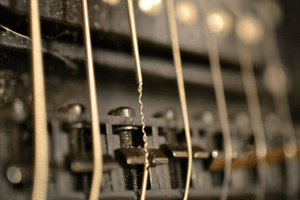
String Breakage
You never know when you will break a string, so always carry an extra set in your guitar case with a string winder.
Strings Are Too Thin
Stings that are too thin are among the most common causes of string breakage, especially with aggressive whammy bar use.
Thin gauge strings can also give you a less rich sound and a lower pickup signal output.
I used Dan Armstrong .007 gauge strings on my Strat in high school. I was frequently overbending my high E string and breaking it. I could not buy .007 gauge strings as singles, so I went through one or two packs of strings a month, sometimes three!
So, if you keep breaking strings, maybe it’s time to move up a gauge.
Strings Are Worn Out
Strings will start to break as they wear out due to metal (or nylon) fatigue. If you change your strings when they first begin to sound bad (typically less bright), you can avoid the drama of most episodes, which seem to happen at the worst possible moment, like in the middle of a song at band practice or while you’re on stage.
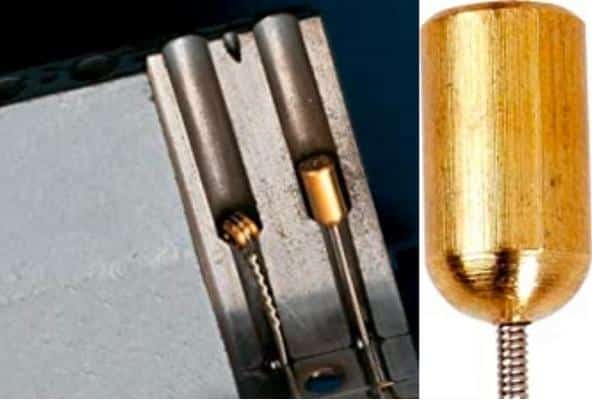
Strings Are Breaking At The Bridge (Twisted) End
The twisted (ball) end of a guitar string is particularly prone to breakage, especially if you are a string bender or like using the whammy bar.
The thinner the string, the more likely it will break in this area.
Fender “Bullet” strings provide an excellent solution for players that use a “Strat-type” tremolo block. These strings have “bullet-shaped” end pieces that are soldered onto the string, so there is no twisted area to break.
Additionally, the bullet is shaped to sit perfectly in a Fender tremolo block so that your strings are less likely to go out of tune when you release the string pressure by depressing the whammy bar. I use these strings, and they do precisely what they are made for.
Strings Are Being Damaged On The Bridge Saddles
This is a common cause of string breakage with guitars that have whammy bars, although double-locking tremolos seem to be less prone to this type of mishap.
“Notched” bridge saddles with burrs or rough edges are especially likely to break strings. Adding a thin layer of lubrication to the notch can help eliminate the problem.
Cleaning Your Guitar Strings
Between string set changes, it’s essential to keep them clean. If you wait until your strings sound bad, cleaning them will probably not make much of a difference.
You should clean them after each time you play. If you haven’t used your guitar in a long time, you should inspect them for dirt, oxidation, and rust before tuning or playing.
When you clean your strings, it’s essential to clean them on the top, sides, and underneath. You might be surprised how much gook can build up on the bottom of your strings where they contact the frets, especially if your hands sweat a lot when you play.
Commercial String Cleaners
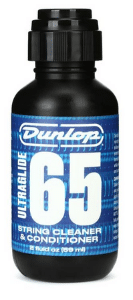
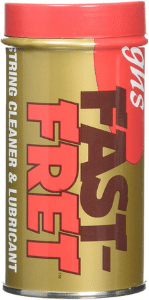
I have tried all types of string cleaners over the years, but I really like the Dunlop 6582 Ultraglide 65 String Conditioner, which extends the life of strings by preventing tarnish and corrosion.
The other product I have used for years is GHS Fast Fret, which is a silicone-free string cleaner and lubricant. Does it really make you play faster? It could, because it decreases friction between the strings and your fingers, especially on the wound strings.
Fast Fret certainly won’t make you a better player than you already are. The real trick to playing fast and at proper tempo is practicing slow and slowly building up speed.
Isopropyl Alcohol And “String Boiling”
I don’t recommend using alcohol, which can dry out the wood on your fretboard, damage the body’s finish, and affect some plastic parts. It can also cause the strings to squeak more as you play them.
I know some players who soak their strings in alcohol or boil them to rejuvenate them. I don’t recommend either one of these methods. Once you remove worn-out strings from a guitar, they will not play right when you reinstall them. It’s better to keep them on the guitar a little longer until you can buy a new set.
Boiled strings can become stiffer, which means they will require a higher tension to bring them up to proper pitch. This can make them harder to bend, affect intonation, and throw the neck out of alignment. It’s just not worth the trouble and the risk of damaging your instrument!

Advantages Of New Guitar Strings
Always carry a new complete set of strings in your guitar case. If you break a string, you can replace it on the spot and change the rest of the strings later.
Here are some of the main advantages of changing your guitar strings often.
- Less likely to break a string while playing
- Stings sound brighter
- Enhanced harmonics
- String buzz is minimized
- Easier to do finger bends and vibrato
- Keeps the fretboard and frets cleaner
- Minimizes problems with intonation

Disadvantages Of Old Guitar Strings
As you continually play your guitar, the strings build up layers of dirt, dead skin, sweat, and oil from your fingers.
Once you think your guitar will sound better with a new set of strings, then you’ve probably waited too long.
It’s a good idea to get into the habit of changing your strings on a routine basis, like once every 1 to 3 months, depending on how much you play. Even if you don’t play the guitar, the surface of nickel strings will eventually oxidize and affect the sound.
Here are some of the problems you’re likely to encounter with strings that are too old or worn out.
- Easier to break a string, especially with bending or whammy bar
- Strings sound dull
- Problems with intonation
- Strings more likely to buzz
- Harmonics do not ring out clearly
- Dirty strings can make your fretboard and frets can dirtier quicker

Beware Of Temperature And Climate Change!
Sudden and gradual changes in temperature can throw your guitar out of tune, mainly by affecting your strings, especially if they are metal (versus nylon).
Metal strings can expand when heated, making your guitar sound flat. As metal strings cool down, they can contract, making your guitar sound sharp.
If you enter a room that is colder or hotter than usual, plan on giving the strings at least 15 or 20 minutes to acclimate before checking the tuning and beginning to play music.
Never store your guitar in an environment that is too cold or too hot, especially if it is an acoustic, hollowbody, or semi-hollowbody instrument! Ideally, guitars should be kept and stored at “room temperature.” You wouldn’t want to be too cold or too hot, and neither do your guitars!

String-Change Checklist
Here are some things you should do whenever you routinely change the strings on your guitar.
- If it’s been a while between string changes, remove all the strings at once, so you can properly clean the frets and fretboard
- Check the nuts on your tuning machine winding poles to be sure they are secure
- Visually check the neck for fret wear
- Clean the tops and sides of each fret
- Clean and polish the fretboard
- Unfinished fretboard – Wipe down with microfiber cloth, nothing else. Wipe with a damp cloth if you need to remove built-up dirt and grime.
- Maple fretboard – Use an all-purpose product, like “Dunlop 65 Guitar Polish And Cleaner.”
- Rosewood & ebony fretboard – First clean with 0000 steel wool and wood oil soap, then polish with a small amount of lemon oil, like Jim Dunlop “6554 Dunlop Ultimate Lemon Oil.”
- After replacing all strings, manually stretch each one to help keep them in tune
- Check the guitar’s intonation, neck relief, bridge and saddle screws, and neck plate screws (don’t worry if you don’t know how to do some this these things)
For more info on helpful tools, see Guitar Repair Maintenance Kit – You Need 8 Essential Things!
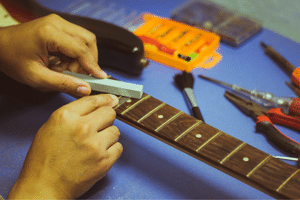
Are You Qualified To Make Guitar Adjustments Or Modifications?
It’s great to work on your guitars, especially if you have a lot of them, but you should always be aware of your limitations.
Adjusting things like an electric guitar’s string height (action) or pickup height can be straightforward. Still, some adjustments require the proper training and experience, like adjusting a guitar’s truss rod.
When you doubt your ability to adjust, repair, or modify your guitar, it’s always best to bring it to a competent guitar technician or luthier (guitar designer & builder). You can permanently damage your guitar, and it might never play and sound right again!
Making modifications to your guitar can void its manufacturer’s warranty and cause permanent damage to the instrument. Certain modifications are irreversible, so you may be stuck with them, even if you desperately want to restore the guitar to its original condition!
I learned that the hard way over the years until I did a three-year apprenticeship in a guitar repair shop. Now I have my own home workshop with the proper training and equipment to safely maintain and repair all my instruments.
Remember: “When In Doubt, Send It Out!”

Frequently Asked Questions
Here are some of the most common questions I get asked about guitars strings and the problems they can cause.
Can I Replace Guitar Strings Myself?
Absolutely. It is a fairly straightforward process once you know how to do it. This is one of the essential maintenance techniques that any guitar player should know.
Is It Easy To Restring A Guitar?
Yes, but like anything new, it takes a little practice to master. After you have done it enough times, it becomes a lot easier and quicker.
There are many instructional videos online that will demonstrate the process. Purchasing a string winder will make things easier. It’s easier to change your strings one at a time, especially if you have a guitar with a floating tremolo.
Can I Fix A Broken Guitar String
Some guitar players try to fix their broken guitar strings, but I don’t recommend it. It’s not something that will quickly solve your broken string problem if you are on stage. Furthermore, The repaired string will never play and sound like a new replacement string, and it can damage your guitar.
The best approach is to discard the broken string and replace it with a new one.
Always carry a set of new strings in your guitar case. I once saw a guitar player try to “quickly” repair a string during a practice session because he didn’t have a new one. It took him over 20 minutes and, the “repaired” string snapped in the middle of his second solo!
Are Guitar Strings Expensive?
The price of guitar strings varies according to string brand, model, and where you buy them. Sometimes it’s cheaper to purchase strings online or in bulk. Beware of “generic” strings that are not properly packaged. Always buy a reliable brand.
If money is tight, you can change them less often but keep them clean and watch for signs that they need to be changed immediately. You should consider guitar strings an essential part of the investment of buying and owning a guitar.
Can I Put Steel Strings On A Classical Guitar?
No! You can only string a classical guitar with nylon strings! Steel (or any other type of metal) strings require a much higher tension to tune up to pitch than nylon strings. The neck and body of a classical guitar are not designed to accommodate that kind of tension.
I serviced a Gibson classical guitar that was severely damaged by someone who restrung it with a set of steel strings. The bridge was loose and almost falling off, with some warping of the top of the body where the bridge was glued to it.
If you want to play steel-string acoustic, get a folk (AKA Spanish) guitar, not a classical guitar!
Do Old Guitar Strings Hurt More?
Old guitar strings will not hurt your fingers more than new strings unless they are rusted or corroded with surface pitting. Stings in this condition can also damage your guitar’s frets and fretboard, so change them immediately if they look or sound bad.
Whenever in doubt about the quality of a string set, you should put on new strings.
How Do You Know When Guitar Strings Are Bad?
Dirty or worn-out guitar strings look dull, discolored, or rusted. These strings should be changed immediately. Even strings that look ok may not sound good or play properly.
Bad strings sound dull and may buzz when fretted. They may be difficult to keep in tune or throw the guitar’s intonation off. Always put on a new string set before attempting to make any adjustments to your guitar to correct these problems.
What Causes A Dead String On A Guitar?
A string may “go dead” if it is dirty, has oxidized, rusted, corroded, or is damaged. Dead strings should be changed immediately to avoid tuning and intonation problems and to prevent damage to frets.
If your guitar has a fresh set of strings and the other strings sound ok, you may have a problem with the neck or some damaged frets under the dead string. A competent guitar technician or luthier (guitar designer and builder) should evaluate this problem.
How Do You Revive A Dead String?
You can try cleaning the dead string if it is not visibly damaged. Be sure to clean the other strings as well. If you have to take the string off to revive it, it’s time for a new set of strings.
Strings should always be replaced, not reused, to have your guitar sound and play its best and to avoid damaging it.
Why Do I Have Fret Buzz On One String?
Sometimes the string can be rusted, corroded, pitted, or deformed. Replace the string to see if that solves the problem. If it does, change the entire set if the other strings are old or worn.
Fret buzz on a single string can also be due to fret wear. The neck may be out of alignment or require a truss rod adjustment (which you should not do unless you have the proper training).
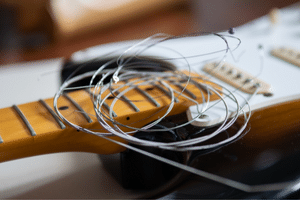
How Long Do Guitar Strings Last?
That depends on a variety of things, such as the quality of the strings, what they’re made of, the type of guitar, how often and how long you play the guitar, your playing style, and the environment (temperature and humidity) that the guitar is kept in.
The average set of strings will last somewhere between 1 to 6 months, with an average lifespan of about 3 months.
How Long Do Nylon Guitar Strings Last?
That depends on various things, such as the quality of the strings, how often and how long you play the guitar, your playing style, and the environment (temperature and humidity) that the guitar is kept in.
Nylon strings typically last less time than steel strings before they begin to lose their tone. You can expect them to last about 1 to 2 months if you play frequently or less if you play professionally.
How Often Do Professional Guitarists Change Strings?
Professional guitar players usually change their strings after 3 or 4 gigs. Some Pros change their strings after every gig, especially if they sweat a lot or play extended solos with an aggressive style and lots of whammy bar parts.
How Do You Clean Rusty Guitar Strings?
You should never clean rusty strings. Always replace them to get the best sound out of your guitar and avoid damaging it.
Can I Boil My Guitar Strings?
I never recommend boiling your strings! Once you remove your strings, they will never sound right when you put them back on. Always keep an extra string set handy and replace your strings once you are no longer to clean them while they are still on the guitar or when they lose their tone.
See the section above on “Cleaning Your Guitar Strings” for more info.
How Do I Prolong The life Of My Guitar Strings?
To prolong the life of your strings, make sure your hands are clean when you play your guitar. If you sweat a lot, then wipe your hands and the guitar neck between songs as the need arises.
If you bend your strings, do finger vibrato, or use a whammy bar often, then your strings will wear out faster.
Always clean your strings, frets, and fretboard thoroughly when you finish playing your guitar.
Is It Bad To Tune Your Guitar Down?
If you don’t have a separate guitar for drop tunings, it is ok to tune your guitar down between songs. Always return your guitar to standard tuning before putting it away unless it is permanently set up in a dropped tuning.
If you use a whammy bar, you will need to lock it or use a “D-Tuna” to keep all the strings in proper pitch after tuning down.
If you detune your guitar frequently, it may cause parts to loosen or wear out faster.
Why Do My Guitar Strings Make My Hands Smell?
Some metal strings that become oxidized or some coated strings may cause your hand to smell after playing for a prolonged time. Some guitar players say their strings make their hands smell like garlic or “old pennies.”

Final Thoughts
Guitar strings can cause a variety of problems for guitar players. It’s essential to recognize the issue and correct it as soon as possible to have your guitar sound and play its best and avoid damaging your instrument.
It’s important to clean your strings after each use and to replace them when they show signs of wear or the tone of your guitar’s sound begins to suffer. Dirty or worn-out strings can cause problems with fret buzz, tuning, intonation, bending, and breakage.
If you change string gauges, be prepared to do a setup on your guitar or have it done by a professional. Never do adjustments or modifications on your guitar without the proper training and tools, or you could permanently damage it!
Temperature and climate change can directly affect the stability of guitar strings. Before playing, give your guitar 15 to 20 minutes to acclimate when moving it to a colder or hotter environment.
I hope you have enjoyed this article on How To Fix Guitar String Problems and found it helpful. If it does not fix your string issue, leave me a comment below, and I will be happy to help you.
What To Read Next ➡ Do Heavier Gauge Strings Stay In Tune Better? Find Out Here!

Tell Me What You Think
Please leave a comment below if you enjoyed this article, have any questions about how to fix guitar string problems, or want to give your point of view. I will be happy to help you.
- Did you fix this article helpful?
- Were you able to fix your string problem after reading this article? If not, why not?
- What type and gauge guitar strings are you using? Why?
- Did article this article make you think about changing string brands or string gauge? Why? Please explain your reason in the comments below




Recently I got a guitar from my grandparents and in all honesty I had no musical ear whatsoever. I wasn’t sure at the time if it was because it was out of tune or if the guitar itself was just bad quality. Once I finally learned how to tune it I learned that it was the guitar strings that made the guitar sound so bad. Luckily I stumbled upon this site and it gave me everything and more. I’m about three months into playing now and feel more inspired now because the sound and just playing the guitar makes me happy.
Hi, L Dominguez
Thank You for your comments!
I’m delighted that you found my article helpful! It’s great that you got the tuning problem all sorted out. There are many free online tuners that you can use with your smartphone, tablet, laptop, or desktop computer.
It can take a while to find the best strings for your guitar.
I recommend taking your guitar to a local music store and getting a basic setup with a string change. The other option is to trade the guitar in for something that plays better if it does not have sentimental value.
The more you play, the more fun it will become. Try to learn something new on the guitar each day, no matter how small. Before you know it, you’ll be making real progress. Don’t forget to check out the hundreds of great online instructional videos.
Please come back and revisit my website soon. In the comment sections of my articles, let me know if you have any questions, and I will be happy to help you!
Best Of Luck & Keep On Playing!
Frank
Your article on keeping your strings was fascinating to me. I started to learn to play the acoustic guitar many years ago and the woman teaching me was a fanatic for keeping the strings clean. I did not understand until years later that a guitar with clean strings ALWAYS had a cleaner sound.
One of my sons loves to play bass but he does not keep his strings clean. His music while technically correct does not sound anywhere nearly as good as when he has clean strings.
Jerry
Hi, Jerry
Thank You for your comments!
Your teacher was correct! Keeping your strings clean and changing them at the first sign of wear is one of the best things you can do to optimize your tone. You can have a $250,000 ’59 Les Paul, but it won’t sound or play right if the strings are shot.
Professional guitar players wipe their strings, frets, and fretboard down after each session.
If you still have that acoustic guitar collecting dust in a closet somewhere, maybe it’s time to pull it out and have some fun! If not, take a drive to the nearest guitar center and find yourself a nice electric that you can jam on with your son! 😊🎸
Stay Safe & Come Back Again,
Frank